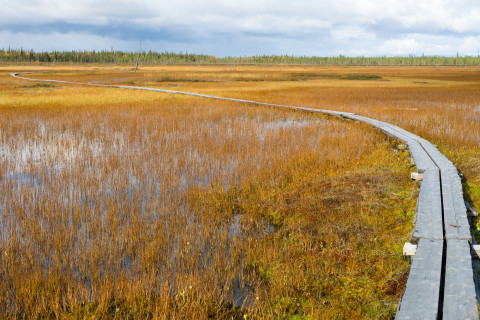The doctoral dissertation in the field of Geography will be examined at the faculty of Social Sciences and Business Studies at Joensuu.
What is the topic of your doctoral research? Why is it important to study the topic?
Mires are a key natural element in Finland, along with forests and water bodies, and they are also important for us humans in many ways. They have been heavily utilized in agriculture and forestry, and today their importance is also increasingly recognized in terms of the carbon balance, water cycle, biodiversity, and as sources of recreation and experiences. In my dissertation, I studied the changes that have occurred and may occur in aapa mires. In addition, the thesis deals with the issues related to the definition and delineation of aapa mires. Aapa mire is a common mire complex type in Finland and widely in the boreal zone. Water arriving from the surrounding catchment is a prerequisite for the development and preservation of aapa mires. Aapa mires are, therefore, sensitive to hydrological changes caused by the surrounding land use. Climate change also affects aapa mires, and changes in aapa mires in turn affect the climate and biodiversity.
What are the key findings or observations of your doctoral research?
The results of the thesis show that aapa mires are widely affected by land use, even regardless of the conservation status, because land use outside the protected area in the catchment of aapa mire may also affect the mire ecosystem through hydrological changes. The results support the notion of rather low degree of naturalness in Finnish mires. In addition, they demonstrate the inevitable change in the aapa mire hydrology as climate change progresses: the seasonal pattern of runoff typical of aapa mires weakens as winters become warmer and with less snow. Climate warming and surrounding drainage can increase the growth of Sphagnum mosses in aapa mires and thereby increase the formation of peat and carbon sequestration. In addition, encroachment of Sphagnum mosses in wet, sparsely vegetated hollows (‘flarks’) can reduce methane emissions and thus mitigate climate change. However, these changes may also reduce biodiversity and landscape diversity.
How can the results of your doctoral research be utilised in practice?
Information on the state and future of aapa mires is needed in the environmental administration to support various assessments and reports related to, for example, threatened habitat types or biodiversity agreements. The research methods developed in the thesis, which utilize geoinformatics and remote sensing, can be applied and further developed in land use planning, environmental change monitoring, and assessments of restoration needs. The thesis also demonstrates the importance of considering the catchments of the mires in nature conservation planning. I hope this is one of the aspects in the thesis that has a practical impact. In addition, the thesis is above all a part of the extensive research body on changes in living nature and climate, important in preparing for and adapting to future changes and investigating the issues further.
What are the key research methods and materials used in your doctoral research?
The central methods of the thesis were geoinformatics, remote sensing, and hydrological modeling. The research materials were the topographic database, elevation models and aerial photographs of the National Land Survey of Finland, the peatland drainage status raster and peatland patch database of the Finnish Environment Institute, Landsat satellite images of the United States Geological Survey, and Finnish Meteorological Institute's weather data sets regarding both historical measurements and future scenarios based on climate models. Through my co-authors, I was also able to utilize the information produced by vegetation and peat studies and drone imagery. The study is part of the SHIFTMIRE project led by docent Teemu Tahvanainen, where changes in northern mires have been studied. My work has been done at the Finnish Environment Institute and the University of Eastern Finland. It started with a personal grant from the Finnish Cultural Foundation’s Kainuu Regional Fund and continued in projects funded by the Academy of Finland and the Kone Foundation.
The doctoral dissertation of Antti Sallinen, M.Sc., entitled Aapa mires in transition: Exploring hydrological and morphological changes in boreal aapa ecosystems, will be examined at the faculty of Social Sciences and Business Studies on 3.11.2023 at 12 noon in the Natura Building, Auditorium N100. The Opponent will be Professor Anne Tolvanen, the Natural Resources Institute Finland (Luke), and the Custos will be Professor Timo Kumpula, University of Eastern Finland. Language of the dissertation event is Finnish. Public examination will be streamed live.
